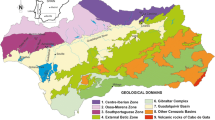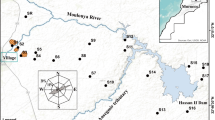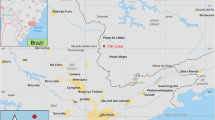Abstract
In the area surrounding the El Teniente giant porphyry copper deposit, eight soil sites were sampled at three depth levels in the summer 2004. The sites were selected for their theoretical potential of being influenced by past SO2 emissions from the smelter and/or seepage from a now idle tailings impoundment. The soil mineralogy, grain size distribution, total organic matter contents, major element composition, cation exchange capacity, and Cu, Mo, Pb, Zn, As and SO4 2− concentrations were determined for all samples after nitric acid extraction and separate leaches by ammonium acetate (pH 7) and sodium acetate (pH 5). For water rinses, only Cu could be determined with the analytical set-up used. Cu and SO4 2− enrichment in topsoils was found at six sites either downwind from the smelter or within the combined influence of the smelter and the tailings impoundment. Both elements were released partially by ammonium and sodium acetate extractions. Due to the scarce background trace element concentrations of soil and rock outside the immediate mine area, assessment of trace element mobility for Mo, Zn, Pb and As was difficult. Arsenic was found to be concentrated in soil horizons with high smectite and/or organic matter contents. Mo appears to be linked to the presence of windblown tailings sediment in the soils. Mobilization of Mo, Zn, and As for the acetate extractions was minimal or below the detection limits for the AAS technique used. The presence of windblown tailings is considered to be an additional impact on the soils in the foothills of the El Teniente compound, together with the potential of acidity surges and Cu mobilization in topsoils after rainfalls. Two sites located at the western limit of the former SO2 saturated zone with strongly zeolitized soils and underlying rock did not show any Cu or SO4 2− enrichment in the topsoils, and remaining total trace element concentrations were below the known regional background levels.









Similar content being viewed by others
References
Ahumada I, Escudero P, Ascar L, Mendoza J, Richter P (2004) Extractability of arsenic, copper, and lead in soils of a mining and agricultural zone in central Chile. Commun Soil Plant Anal 35:1615–1634
Boletin Minero (2004) La visión de Braden. Sociedad Nacional de Minería, Santiago de Chile, Boletín Minero, Nr 1186:6–9
Camus F (1975) Geology of the El Teniente ore body with emphasis on wall rock alteration. Econ Geol 70:1341–1372
Cares R (2004) Caracterización de la petrografía, geoquímica y mineralogía metálica y de alteración de los intrusitos mayores y de alteración del prospecto La Huifa-La Negra, yacimiento El Teniente, VI Región, Chile. Undergraduate thesis, Departamento de Ciencias de la Tierra, Universidad de Concepción, Chile, p 142
CICA Ingenieros Consultores (1998) Evaluación de impacto ambiental proyecto lixiviación de relaves en pilas, tranque Barahona, resumen ejecutivo. Unpublished report, Codelco El Teniente, Rancagua, Chile
CIMM (1995) Estudio de impacto ambiental planta de ácido sulfúrico fundición Caletones, P-935089. Unpublished report, Codelco El Teniente, Rancagua, Chile
Codelco (2001) Declaración de impacto ambiental: Proyecto Bodega almacenamiento reactivos y materiales Barahona. Unpublished report, Codelco El Teniente, Rancagua, Chile
Codelco (2005a) Unpublished records of the El Teniente hydronivometeorological centre at Sewell Station, 2155 m a.s.l
Codelco (2005b) Principales indicadores de gestión, producción año 2004, Informe Superintendencia Gestión Producción SPG-I-003-05, marzo 2005. Unpublished report, Codelco El Teniente, Rancagua, Chile
De Gregori I, Fuentes E, Rojas M, Pinochet H, Potin-Gautier M (2003) Monitoring of copper, arsenic and antimony levels in agricultural soils and impacted and non-impacted by mining activities, from three regions in Chile. J Environ Monit 5:287–295
Dold B, Fontbote L (2001) Element cycling and secondary mineralogy in porphyry copper tailings as a function of climate, primary mineralogy and mineral processing. J Geochem Explor 74:3–55
Domić EM (2001) Hidrometalúrgica, fundamentos, procesos y aplicaciones. Andros Impresores Ltda., Santiago, Chile, p 947
Dudka S, Adriano DC (1997) Environmental impacts of metal ore mining and processing. A review. J Environ Qual 26:590–603
Ecclestone S (ed) (1996) Environmental management in Chile, report 1996. can-chile.gc.ca/English/Resource/Reports/ChileEM/ChileEM( index.cfm
Gramusset A (2003) Geoquímica base de la Cuenca del Río Coya-Distrito El Teniente. Universidad de Chile, unpublished final year student project, Santiago de Chile
Hall GE, Vaive JE, Beer R, Hoashi M (1996), Selective leaches revisited, with emphasis on the amorphous Fe oxyhydroxide phase extraction. J Geochem Explor 56:59–78
INIA (1985) Suelos volcánicos de Chile, INIA—Ministerio de Agricultura, Santiago, Chile, p723
INTEC (1985) Proyecto relaves Barahona, Codelco Chile División El Teniente. Informe Ejecutivo de Lixiviación. Unpublished report, Codelco El Teniente Division, Rancagua, Chile, p 40
Jambor JL, Nordstrom DK, Alpers CN (2000) Metal-sulfate salts from sulfide mineral oxidation. In: Sulfate minerals. Reviews in mineralogy and geochemistry 40, Mineralogical Society of America Geochemical Society, pp 304–350
Kelm U, Helle S (2003) An experimental study of the interaction of malachite, atacamite and chrysocolla with a reactive gangue during sulfuric acid leaching. Hydrometallurgy of copper (Book 1). Leaching and process development. In: Riveros et al. (eds) Proceedings Cobre/Copper 2003, Santiago de Chile, pp 117–130
Ministerio de Minería (1994) Decreto Oficial No 179, 16.11.1994
Nagy KL (1995) Dissolution and precipitation kinetics of sheet silicates. In: White AF, Brantley SL (eds) Chemical weathering rates of silicate minerals, reviews in mineralogy 31, Mineralogical Society of America, pp 173–234
Parker A, Rae JE (1998) Environmental interactions of clays. Clays and the environment. Springer, Berlin, p 271
Plumlee GS (1999) The environmental geology of mineral deposits. In: Plumlee GS, Logsdon ML (eds) The environmental geochemistry of mineral deposits. Part A: Processes, techniques, and health issues. Reviews in Economic Geology, vol 6A, pp 71–116
Schachtschabel P, Blume HP, Hartge KH, Schwertmann U (1979) Lehrbuch der Bodenkunde. Ferdinand Enke Verlag, Stuttgart, p 394
Smith KS, Huyck LO (1999) An overview of the abundance, relative mobility, bioavailability, and human toxicity of metals. In: Plumlee GS, Logsdon ML (eds) The environmental geochemistry of mineral deposits. Part A: Processes, techniques, and health issues. Reviews in Economic Geology, vol 6A, pp 29–70
SMSHL (2000) Informe final. Línea base de arsénico del material particulado respirable. Proyecto CONAMA (Comisión Nacional de Medio Ambiente), 22–0023-09, Unpublished report, Codelco, El Teniente, Rancagua, Chile
Walton-Day K (1999) Geochemistry of the processes that attenuate acid mine drainage in wetlands. In: Plumlee GS, Logsdon ML (eds) The Environmental geochemistry of mineral deposits. Part A: Processes, techniques, and health issues. Reviews in Economic Geology, vol 6A, pp 215–228
Acknowledgments
The research was funded by CONICYT (Chilean Science Foundation, Fondecyt Project 1010823). The authors thank the GEA Institute and the Codelco staff for their help at all stages of sample analysis. Permission given by the Codelco El Teniente Division to publish is appreciated, as are the comments by anonymous reviewer(s).
Author information
Authors and Affiliations
Corresponding author
Rights and permissions
About this article
Cite this article
Kelm, U., Helle, S., Matthies, R. et al. Distribution of trace elements in soils surrounding the El Teniente porphyry copper deposit, Chile: the influence of smelter emissions and a tailings deposit. Environ Geol 57, 365–376 (2009). https://doi.org/10.1007/s00254-008-1305-1
Received:
Accepted:
Published:
Issue Date:
DOI: https://doi.org/10.1007/s00254-008-1305-1




